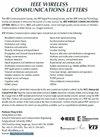具有RFID后向散射体的noma支持ISAC系统的优化资源分配
IF 5.5
3区 计算机科学
Q1 COMPUTER SCIENCE, INFORMATION SYSTEMS
引用次数: 0
摘要
本文研究了具有集成传感和通信(ISAC)的反向散射通信环境中支持非正交多址(NOMA)的多用户传输系统。在这种配置中,基站(BS)通过通信波束同时为多个用户提供服务,同时利用传感波束检测射频识别(RFID)标签的存在。在考虑所有通信用户的连续干扰消除(SIC)约束和最低服务质量(QoS)约束以及标签检测的同时,提出了一种联合波束形成设计问题,以最大限度地提高用户的和速率。利用拉格朗日对偶变换解决了目标函数的非凸性。针对变量的耦合性,提出了一种保证收敛性的交替优化算法。通过数值仿真,验证了算法的有效性。此外,我们还评估了几个关键参数对系统性能的影响,包括基站的发射天线数量、基站的可用发射功率、通信用户的最低QoS和通信用户数量。本文章由计算机程序翻译,如有差异,请以英文原文为准。
Optimized Resource Allocation in NOMA-Enabled ISAC Systems With RFID Backscatterers
This letter investigates a non-orthogonal multiple access (NOMA)-enabled multi-user transmission system in a backscatter communication environment with integrated sensing and communication (ISAC). In this configuration, a base station (BS) simultaneously serves multiple users through a communication beam while utilizing a sensing beam to detect the presence of an radio frequency identification (RFID) tag. A joint beamforming design problem is formulated to maximize the sum-rate for the users while considering the constraints for successive interference cancellation (SIC) and the minimum quality of service (QoS) for all the communication users and the detection of the tag. Lagrangian dual transformation is used to address the non-convex nature of the objective function. Due to the coupling of variables, an alternating optimization (AO) based algorithm is proposed with guaranteed convergence. Through numerical simulations, we validate the efficacy of our proposed algorithm. Furthermore, we assess the impact of several key parameters on system performance, including the number of transmitting antennas at the BS, the available transmit power at the BS, the minimum QoS for the communication users, and the number of communication users.
求助全文
通过发布文献求助,成功后即可免费获取论文全文。
去求助
来源期刊

IEEE Wireless Communications Letters
Engineering-Electrical and Electronic Engineering
CiteScore
12.30
自引率
6.30%
发文量
481
期刊介绍:
IEEE Wireless Communications Letters publishes short papers in a rapid publication cycle on advances in the state-of-the-art of wireless communications. Both theoretical contributions (including new techniques, concepts, and analyses) and practical contributions (including system experiments and prototypes, and new applications) are encouraged. This journal focuses on the physical layer and the link layer of wireless communication systems.
 求助内容:
求助内容: 应助结果提醒方式:
应助结果提醒方式:


